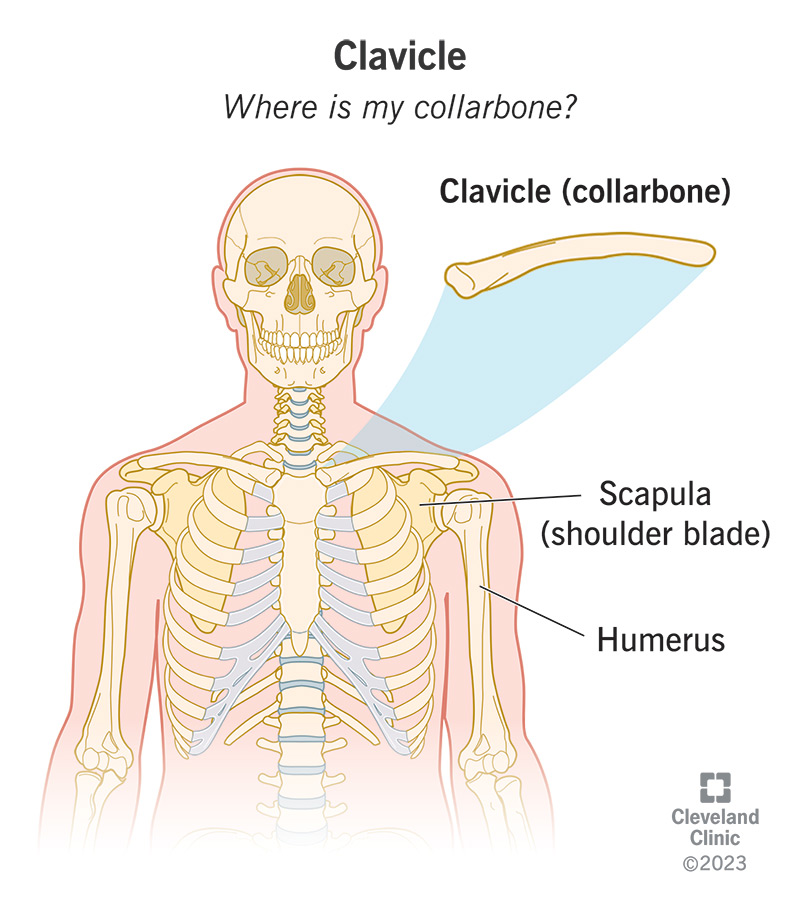Your clavicle (collarbone) is a part of your skeletal system that connects your arm to your body. Ligaments connect this long, thin bone to your sternum and shoulder. Your clavicle is prone to injuries like a clavicle fracture, dislocated shoulder and separated shoulder. Falls are a top cause of clavicle injuries.
Advertisement
Cleveland Clinic is a non-profit academic medical center. Advertising on our site helps support our mission. We do not endorse non-Cleveland Clinic products or services. Policy

Your clavicle (collarbone) is a long, slightly curved bone that connects your arm to your body. You’ll find one on both sides of the base of your neck. The bones help keep your shoulder blade in the correct position as you move.
Advertisement
Cleveland Clinic is a non-profit academic medical center. Advertising on our site helps support our mission. We do not endorse non-Cleveland Clinic products or services. Policy
The word “clavicle” comes from the Latin “clavicula,” which translates to “little key.” The bone is actually shaped a bit like an old-fashioned key. And it works in much the same way. When you rotate a key, it moves the lock. Similarly, when you lift your arm, your clavicle rotates along its axis to allow movement.
Because of its location and role in shoulder movement, your clavicle bone is prone to injury. These injuries are common in contact sports, falls (especially when you put your arm out to catch yourself) and trauma like car accidents. Sometimes, babies can get a clavicle injury during birth.
Your clavicles are bones, and bones are made of layers of cells and proteins. They have a hard outer layer or shell, and an inner layer of spongy bone (cancellous bone) tissue.
Your clavicles are long bones that support your upper body and play an important role in how you move. They hold your shoulder in place, allowing you to transfer weight from your upper body to your head, neck, back and chest (your axial skeleton).
In an adult, each clavicle is about 6 inches long and runs along the top of your chest at the front of your shoulder. It runs horizontally (from side to side). Strong bands of tissue (ligaments) connect your sternum (breast bone) in the middle of your ribcage to your shoulder blade (scapula).
Advertisement
Your clavicle is long and narrow. It lies right under the surface of your skin, making it prone to fractures and injuries. Active children, teens and those who play contact sports are more prone to injuries like dislocated shoulders. Adults, especially those who are older, are more prone to falls that cause broken clavicles.
Types of clavicle injuries include:
Other conditions that can affect your clavicle include:
Pain is the most common symptom of clavicle conditions. Other symptoms include:
If you think you’ve broken your clavicle, go to the emergency room (ER). A healthcare provider should diagnose and treat a clavicle fracture as soon as possible to make sure it heals correctly.
A broken clavicle is a common injury in adults. It accounts for about 5% of (1 in 20) adult fractures.
If you have symptoms of a clavicle injury or another clavicle condition, a healthcare provider might suggest one or more of the following imaging tests:
Treatment for clavicle pain or injury depends on what sort of problem you’re having. It might include:
If you’ve fractured your clavicle, you might need surgery to get your bones back where they belong and secure them in place.
These steps can keep your clavicle and the rest of your skeletal system healthy and strong:
Advertisement
There’s no difference between your clavicle and collarbone. It’s the same bone. Some people call it the collarbone because it’s at or near the collar of your shirt.
Your clavicle plays an important role in shoulder and arm movement. Because it’s so thin and close to the skin, the collarbone is one of the most commonly fractured bones. It’s second nature to put out your hand to stop a fall. But the force on your clavicle can cause a fracture or dislocation. See your healthcare provider if you have an injury or experience pain in the collarbone area.
Advertisement
Cleveland Clinic’s primary care providers offer lifelong medical care. From sinus infections and high blood pressure to preventive screening, we’re here for you.

Last reviewed on 07/13/2023.
Learn more about the Health Library and our editorial process.